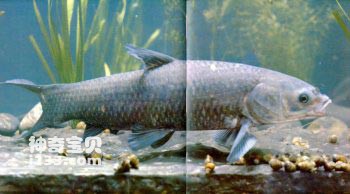Mylopharyngodon piceus belongs to the order Cypriniformes, family Cyprinidae, subfamily Mylopharyngodon, and genus Mylopharyngodon piceus. Commonly known as: black grass carp, green grass carp, and snail green. English name: Blak carp.
The body is long, slightly cylindrical, the tail is flat on the sides, the abdomen is round, and there is no abdominal rib. The head is slightly flat and the tail is flat on the side. The mouth end is curved. The upper jaw is slightly longer than the lower jaw. No need. There is 1 row of hypopharyngeal teeth, molar-shaped, with smooth chewing surface and no grooves. The dorsal fin and anal fin have no spines, and the dorsal fin is opposite to the pelvic fin. The back of the body and the upper half of the sides are blue-black, the abdomen is gray-white, and each fin is gray-black.

Generally live in the middle and lower layers of larger water bodies with many snails at the bottom. Their food mainly consists of snails, mussels, clams, clams, etc. They also prey on shrimps and insect larvae. It grows quickly, reaching 3-5 kg in 2-3 winter years, and the largest individual can reach 70 kg. Common individuals in the Yangtze River weigh about 15-20 kg. Sexual maturity is 4-5 years old. From April to July, they breed in places with high flow rates in the main streams of rivers. After reproduction, they are often concentrated in river bays and lakes connected to rivers for fattening. They overwinter in deep water in winter.
Black carp is mainly distributed in the plain areas south of the Yangtze River in China, and is rare in the north of the Yangtze River. It is an important fishery resource in the middle and lower reaches of the Yangtze River and lakes along the river, and is the main cultured object in various lakes and ponds. It is one of the "four types of freshwater aquaculture in China". One of the "big fish".
Black carp is large in size and grows rapidly, making it an important economic fish in my country. The meat is plump and tender, and tastes fresh and juicy, especially in winter. It contains 15.8-19.5 grams of protein per 100 grams of edible portion, 2.6-5.2 grams of fat, 96-125 kcal of calories, 25-72 mg of calcium, 171-246 mg of phosphorus, 0.8-0.9 mg of iron, and 0.13 mg of thiamine. Riboflavin 0.12 mg, niacin 0.17 mg.
Herring meat is sweet, flat, non-toxic, beneficial to qi, dampness, neutralization, malaria treatment, nourishing the liver, improving eyesight, and nourishing the stomach; it is mainly used to treat athlete's foot, dampness, depression, malaria, bloody stranguria and other diseases. Its gallbladder nature is bitter, cold, and toxic. It can purge heat, reduce inflammation, improve eyesight, and reduce nebula. It is used externally to treat red and swollen eyes, conjunctivitis, nebula, laryngeal paralysis, deafness, malignant sores, and alopecia. It can be taken internally. Can cure tonsillitis. Since bile is poisonous, it should not be taken excessively. Excessive swallowing of herring gallbladder will cause poisoning. Half an hour later, mild cases may cause nausea, vomiting, abdominal pain, and watery stools; severe cases may cause coma after diarrhea, oliguria, anuria, blurred vision, scleral jaundice, followed by turmoil, convulsions, and teeth grinding. Tight closing, stiffness of limbs, foaming at the mouth, eyeballs moving up, deep and fast breathing. If not treated promptly, it can lead to death.
animal tags:
We created this article in conjunction with AI technology, then made sure it was fact-checked and edited by a Animals Top editor.